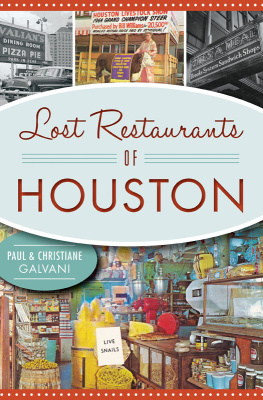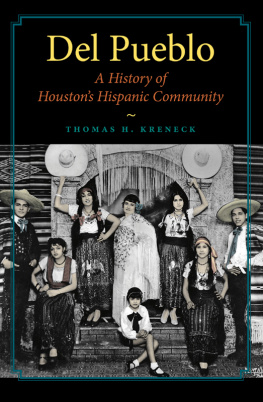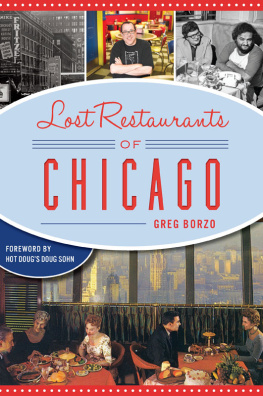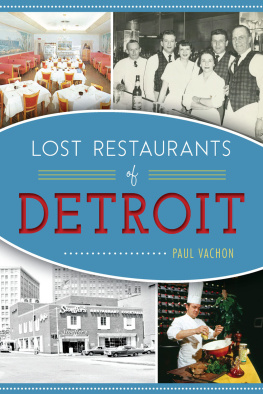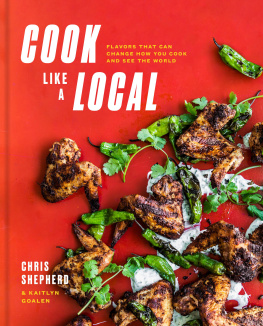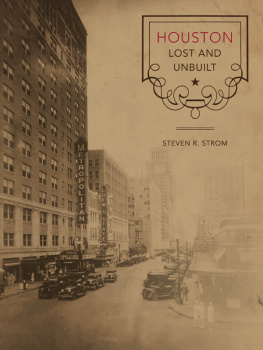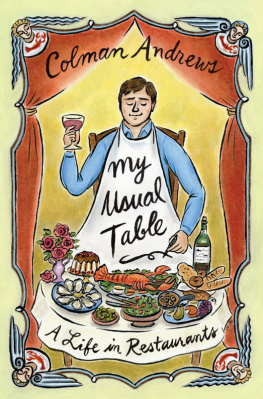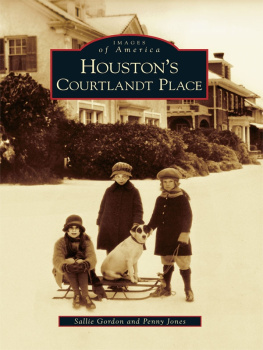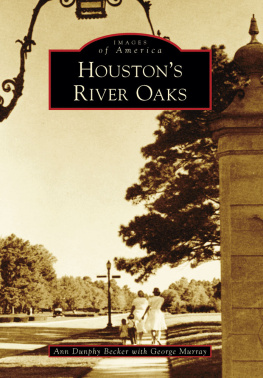


Published by American Palate
A Division of The History Press
Charleston, SC
www.historypress.com
Copyright 2018 by Paul and Christiane Galvani
All rights reserved
First published 2018
e-book edition 2018
ISBN 978.1.43966.461.2
Library of Congress Control Number: 2017963237
print edition ISBN 978.1.46713.828.4
Notice: The information in this book is true and complete to the best of our knowledge. It is offered without guarantee on the part of the authors or The History Press. The authors and The History Press disclaim all liability in connection with the use of this book.
All rights reserved. No part of this book may be reproduced or transmitted in any form whatsoever without prior written permission from the publisher except in the case of brief quotations embodied in critical articles and reviews.
CONTENTS
ACKNOWLEDGEMENTS
Alot of people helped in the production of this book and we want to thank them here.
Thanks Mike McCorkle, for taking and preserving so many photographs; Carol Look, for keeping alive the memory of Sonny; Conrad Janus, for the record-keeping of Houston restaurants; Chris Tripoli, for providing your professional insights as to why restaurants fail; Ronnie Bermann, for still making the terrific tarama salada from Maxims; Mark Bermann, for sharing so many great stories about your father; Joel Draut at the Houston Metropolitan Research Center, for taking an interest in this project and for finding images for us; Story Sloane III, for preserving so many photographs; Amanda Focke at the Woodson Research Center at Rice University, for pointing out that which was right in front of my eyes; Mark Young, PhD, and Maria Corsi, PhD, for being the keepers of the Hospitality Industry Archives at the Hilton School; Herb Oberman, for going to that estate sale while on your honeymoon and buying that first menu that started it all and helped you amass thirty thousand of them; Ann Criswell, for being the first Houston foodie rock star and for teasing and teaching the taste buds of generations of Houstonians; Nancy Youngblood Counts, for sharing your Youngbloods memorabilia; Debbie Garrett, for keeping the memories of Ones A Meal alive; Patty Ramsey, for Valians memories; and Theresa Matranga Neal, for keeping the box of memories full of photos.
Well be remembered more for what we destroy than what we create.
Chuck Palahniuk, Invisible Monsters (1999)
I knew I was finally a Houstonian when the name Ima Hogg no longer sounded strange to me.
anonymous
KUDOS HOUSTON!
There is no doubt about itHouston is a foodie town. The City of Houston Department of Health and Human Services, which oversees the food and beverage industries, tells us that we have 14,129 food establishments in the Houston city limits, of which 6,340 are restaurants. In the event that you decided to eat lunch and dinner at a different restaurant every day, it would take you almost nine years to try them all. A recent garnering of accolades from various national publications confirms that the Houston restaurant scene has made it to national prominence. In 2016, Travel + Leisure listed Houston as One of the Best Cities for Foodies, U.S. News & World Report ranked Houston number seven in the Best Foodie Destinations in the U.S.A. and GQ magazine named Houston Americas Next Great Food City and The Next Global Food Mecca. John T. Edge, the director of Southern Foodways Alliance, said, Houston boasts the most dynamic and diverse food and drink scene in the nation. In 2015, the Washington Post listed Houston as the no. 5 pick of the 10 Best Food Cities in America, and Travel & Leisure ranked Houston no. 1 in Americas Best Cities for Food Snobs. In 2013, Food & Wine magazine called Houston Americas Newest Capital of Great Food. When you land at one of the two airports in the city, you are greeted by a sign proclaiming Houston The Culinary and Cultural Capital of the South. Local chefs have turned into celebrities, and we eagerly await the opening of the latest restaurant. Almost every chain restaurant in the country has an outpost here, and the most recent to add to the vast array of offerings are from newcomers Guss World Famous Fried Chicken, based in Memphis, and California-based In-N-Out Burger, both of which are slated to open in 201718.
It seems as though Houston has always drawn people to come and live here, and restaurants have followed. This is what one writer said about the city in a Houston Post article on April 5, 1910:
It would be difficult for me to find a city in the State of Texas in which so many young people are employed in various enterprises as there are in Houston. This is due to the fact that there has been great demand for both male and female help in this section of the country for a number of years past. As a result of the influx of people into the city in response to this call, Houston has become one of the best restaurant towns in the South.
Eating out in Houston didnt become as popular as it is today until the midtwentieth century. The immense diversity of ethnic restaurants that defines Houston today was certainly not a feature of Houston in the 50salthough ethnic restaurants have existed almost as long as the city has been around. Aside from some Tex-Mex and Chinese places, there was virtually no other ethnic food available. Before biryani, bahn mi and bagels, and prior to pho, pancetta or pakora, eating out meant beef and lots of iteven Ding How, a Chinese restaurant popular in the 1960s, featured K.C. Steaks along with its traditional food offerings.
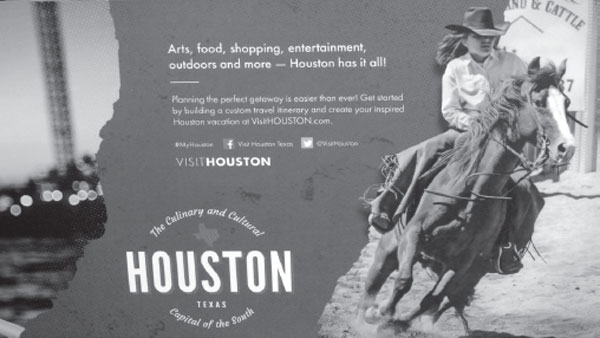
Photo by Paul Galvani.
In the 50s, coffee was from a percolator, and Houstonians were just discovering wines. There was no craft or artisanal anything: salad was iceberg, dressing was green goddess, national grocery chains did not exist, there were only small local food stores in neighborhoods, there were no food channels on TV. If we didnt recognize it, we didnt eat it. Vegetables were from a can; seafood meant shrimp, crab, oysters and snapper. Neither arugula nor artichokes had made their debut. Food went from being a chore to what it is today: exciting. Food as fuel turned into food as fun. In the early days of Houston, dining out was purely functional, with mainly men eating out at lunch. Social dining, or dining out as entertainment, was not something Houstonians did at that time. By the mid-1950s, people went out to eat to celebrate special family occasions and mark business eventspretty much the same reasons we go out to eat today for what could be considered an important meal. Whats different about today is that people go out to eat much more often and not just for important meals. We go out because we can, because eating out in Houston is relatively cheap and the number of different offerings is simply enormous and because many people lack the time, cooking skills and desire to prepare a meal from scratch. There is an often-quoted statistic that Houstonians eat out an average of over four times per week, more than the residents of any other U.S. city, according to the Zagat Survey LLC. The first Zagat Guide of Houston restaurants was published in 1989.
Next page
